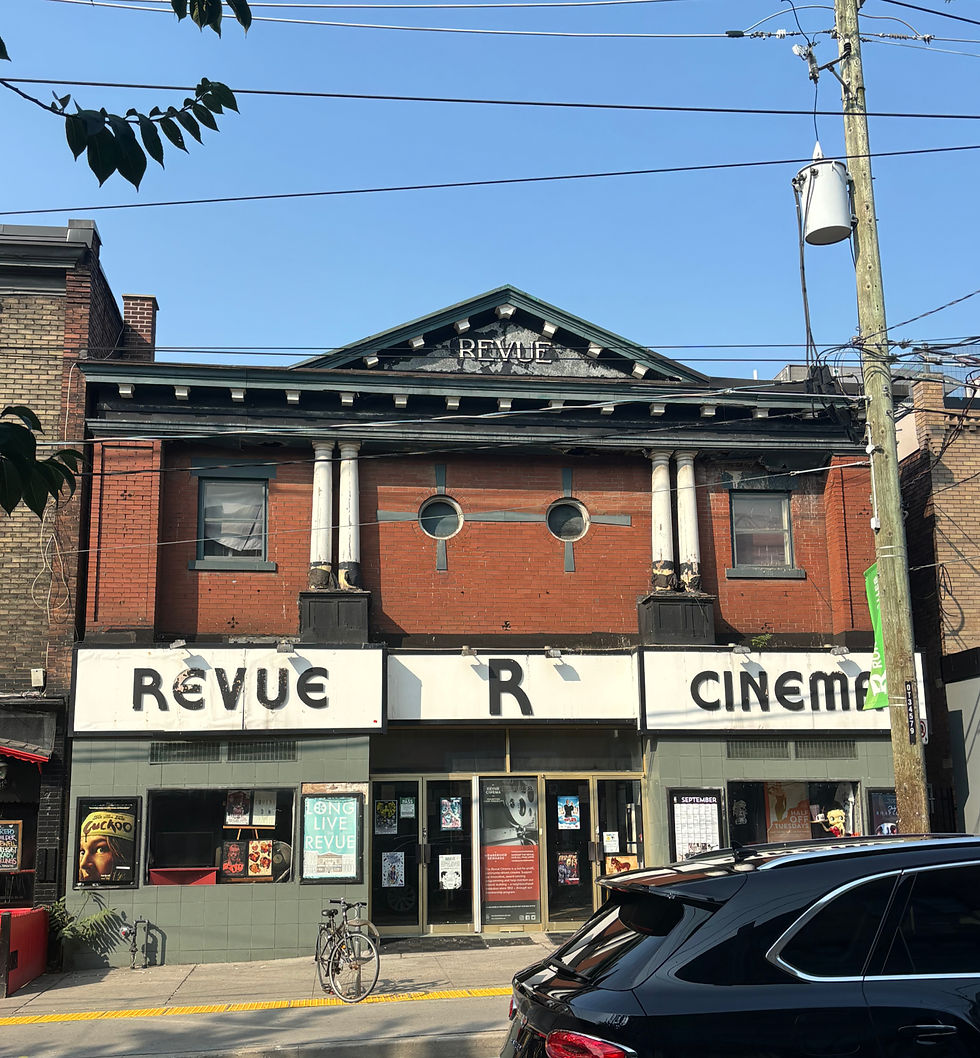Preserving the Past: The Revue Cinema’s Long-Awaited Restoration Project (Web Exclusive)
- Ornamentum
- Jul 20
- 5 min read
Updated: Jul 27
By David Saric

“I feel like I am a Torontonian filmmaker,” director Guillermo Del Toro once professed to Toronto.com. Having spent years in and around the city filming various projects, including his Oscar-winning period piece, 2017’s The Shape of Water, the genre-bending cinematic luminary has gone on to anoint Toronto as his second home.
Thus, it should come as no shock that when the ailing, but historically-significant, architectural exterior of the Revue Cinema — Canada’s oldest operating movie theatre — was in need of a dire restoration, Del Toro seized the opportunity to help the renowned cultural landmark.
“Guillermo [Del Toro] became aware of some of the challenges the Revue was facing after seeing an outpouring of support online last year,” said Grant Oyston, current vice-chair of the Revue Film Society, the non-profit organization that operates the Revue Cinema.
“He very kindly offered to host a fundraising screening and Q&A of his film, Crimson Peak, in October [2024]. We were thrilled and honoured to host him, and no surprise, the screening sold out within minutes of going online.”
It is because of altruistic endeavours like this, bolstered by public encouragement for cultural preservation in a time of rampant corporatization and gentrification, that independent community relics like the Revue are given a chance to stand tall. This independent theatre in Toronto’s Roncesvalles neighbourhood is entering its second century of operation – it’s an institution.
Efforts to save the Revue also show a desire to prevent Toronto’s architectural history (and all its aesthetic variances) from being erased by commercial developments that prioritize function over character, or falling victim to “facadism.” The latter refers to a specific type of historical preservation wherein a building’s facade is left in place while the rest of the original structure is demolished and replaced with new construction; some would argue leaving only the facade is merely a superficial gesture that lacks respect for a building’s historical and cultural context.
A History of the Revue’s Original Facade

When the Revue was first being built — known then as the Review Cinema — there was a cultural shift around the idea of a movie house, or theatre, and its role within society.
“The motion picture business was quickly evolving from a novelty, where people would stand in a converted store and watch a train projected onto a pinned-up sheet, into a more sophisticated form of entertainment,” Oyston said.
As such, the disintegration of the cinematic viewing experience as novelty, coupled with a more sophisticated approach to storytelling, meant there was opportunity for a robust business to cater to a larger interest in this burgeoning medium, while also establishing a community hub in the process.
“I think the facade reflects that early optimism about the future of cinema, but also reflects the Revue’s status as primarily a local, neighbourhood cinema — it is modest but elegant, inviting but dignified,” Oyston added.
Originally decorated in an Edwardian style, the original architectural firm — Suburban Amusement Co. — would have eschewed the heavy, ornate style of Victorian architecture that dominated the area previously, in favour of something more modern, simple and functional.
However, in 1936, the firm of Sprachman and Kaplan were hired to undertake a $10,000 renovation, which was when Art Deco elements were added to the building’s interior, as well as its signature marquee, creating a composite style that, according to Oyston, creates a nice balance of “refined yet cozy.”

According to Michael Windover, Associate Professor; Head of Art and Architectural History at Carleton University, Sprachman and Kaplan were “very adept at creating fashionably modern environments.”
While it may seem aesthetically incongruous to fuse two disparate styles like Art Deco and Edwardian into one building, doing so was a reflection of the era’s preoccupation with modernity.
“The interior of the Revue would have been coded fashionably modern and read like other movie houses as a place for a modern everyday practice (moviegoing),” Windover said.
“Movie theatres as buildings are interesting as they set the tone for the activity. They could do that through refinement, with established historical references, imaginative decorative schemes, like atmospheric theatres, or through a modern design idiom, like Art Deco.”

Preserving a National Icon
In 2006, the Revue was designated by the city of Toronto as being of “cultural heritage, value or interest.”
As noted on the city’s by-law document, this distinction is directly related to the “building’s design or physical value as a representative example of a World War I era theatre with features of Edwardian Classicism. The style developed after 1900 and represented a return to restrained Classical detailing that was popular for all building types during the subsequent decades.”
Renovating the building’s exterior in a manner that preserves its original aesthetic principles while also ensuring its pragmatic endurance was of utmost importance to those at the Revue, which, in 2024, was almost met with a forced foreclosure due to a dispute with its landlord.
“The restoration was almost entirely completed last fall,” Oyston said.
This involved replacing damaged soffits, repairing the columns and pedestals, replacing the Revue Cinema signage, installing new exterior lighting, installation of bird control spikes and repainting many elements, among other minor fixes.
“Our goal was both to keep the cinema looking welcoming and attractive as a key part of the Roncesvalles streetscape, and also to protect the heritage façade from deterioration over years to come,” Oyston added.
Photos showing the restoration in-progress, between October and December 2024. The image on the bottom right shows The Revue post-restoration, as of June 2025. Photos by Grant Oyston.
However, the building’s marquee, which was erected in the 1930s and collapsed in 2007, has yet to be rebuilt, mainly due to bureaucratic issues: “We don’t own the building, and as a local non-profit arts organization, we don’t have the funding required for such a large-scale construction project,” Oyston admitted.
Restoring the façade for present and future generations only works to emphasize the Revue’s existence as one of the last neighbourhood cinemas in operation in Toronto, as well as a premier independent cultural hub in Canada edifying audiences with unique and diverse programming.
“Buildings embody ideas and values. As pieces of the past that live in the present, they tell us about who we are and where we’ve come from,” Windover said, adding, “They provide a way for us to engage with those that have come before us. If cities are seen as incubators or accelerators of ideas, having a rich library of sources can help not only provide stability but also inspire novelty and innovation.”

Oyston similarly echoed Windover’s thoughts on the act of preservation creating a phenomenological through-line between generations past, present and future through moviegoing.
“I hope our audience today feels the same anticipation and excitement walking into the Revue as our first audience did 113 years ago, knowing they’re about to have a unique experience that they couldn’t find anywhere else,” he said.
And what better portal than through the building’s façade, especially one that is both distinctive and reverent.












Comments